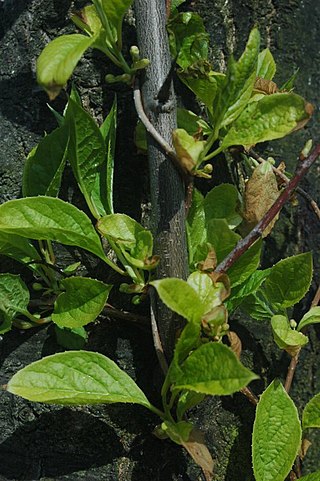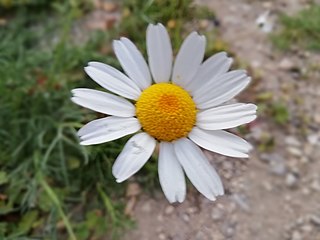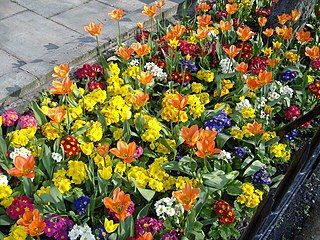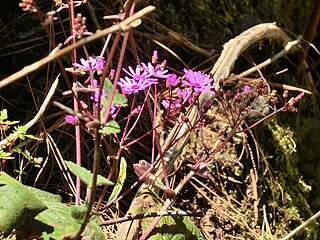
Anemone is a genus of flowering plants in the buttercup family Ranunculaceae. Plants of the genus are commonly called windflowers. They are native to the temperate and subtropical regions of all continents except Australia, New Zealand, Antarctica and the Middle East. The genus is closely related to several other genera including Anemonoides, Anemonastrum, Hepatica, and Pulsatilla. Some botanists include these genera within Anemone.

Petunia is a genus of 20 species of flowering plants of South American origin. The popular flower of the same name derived its epithet from the French, which took the word pétun, 'tobacco', from a Tupi–Guarani language. A tender perennial, most of the varieties seen in gardens are hybrids.

Cineraria is a genus of flowering plants in the sunflower family, native primarily to southern Africa with a few species farther north. The genus includes herbaceous plants and small subshrubs.

Pericallis is a small genus of 15 species of flowering plants in the family Asteraceae, native to the Canary Islands, Madeira and Azores. The genus includes herbaceous plants and small subshrubs. In the past, the genus was often included in either Cineraria or Senecio.

Streptocarpus is an Afrotropical genus of flowering plants in the family Gesneriaceae. The genus is native to Afromontane biotopes from central, eastern and southern Africa, including Madagascar and the Comoro Islands. The flowers are five-petalled, salverform tubes, almost orchid-like in appearance, and hover or arch over the plant, while the pointed, elongate fruit is of a helical form similar to that of the "tusk" of a narwhal. In the wild, species can be found growing on shaded rocky hillsides or cliffs, on the ground, in rock crevices, and almost anywhere the seed can germinate and grow. For the home, there are now many hybrids of various colours and forms available.

Schisandra chinensis, whose fruit is called magnolia berry or five-flavor fruit, is a vine plant native to forests of Northern China, the Russian Far East and Korea. Wild varieties are also found in Japan. It is hardy in USDA Zone 4. The fruits are red berries in dense clusters around 10 centimetres (3.9 in) long.

Matthiola longipetala, known as night-scented stock or evening stock, is a species of ornamental plant.

Aurinia saxatilis is an ornamental plant native to Asia and Europe.

Liatris spicata, the dense blazing star, prairie feather, gayfeather or button snakewort, is a herbaceous perennial flowering plant in the family Asteraceae. It is native to eastern North America where it grows in moist prairies and sedge meadows.

Oenothera fruticosa, the narrowleaf evening primrose or narrow-leaved sundrops, is a species of flowering plant in the evening primrose family.

Hedlundia hybrida, the Swedish service-treeFinnish whitebeam, or oakleaf mountain ash, is a species of whitebeam native to Norway, eastern Sweden, south-western Finland, and locally in Latvia.

Hylotelephium spectabile is a species of flowering plant in the stonecrop family Crassulaceae, native to China and Korea. Its common names include showy stonecrop, iceplant, and butterfly stonecrop.

Oxalis triangularis, commonly called false shamrock, is a species of perennial plant in the family Oxalidaceae. It is native to several countries in southern South America. This woodsorrel is typically grown as a houseplant but can be grown outside in USDA climate zones 8a–11, preferably in light shade.

Argyranthemum frutescens, known as Paris daisy, marguerite or marguerite daisy, is a perennial plant known for its flowers. It is native to the Canary Islands. Hybrids derived from this species are widely cultivated as ornamental plants in private gardens and public parks in many countries, and have naturalized in Italy and southern California. There are many cultivars, but the most common has white petals.

Many types of flowering plants are available to plant in flower gardens or flower beds. The floral industry calls these plants, bedding plants. These fast-growing plants in seasonal flower beds create colourful displays, during spring, summer, fall or winter, depending on the climate. Plants used for bedding are generally annuals, but biennials, tender perennials, and succulents are used.

Hydrangea serrata is a species of flowering plant in the family Hydrangeaceae, native to mountainous regions of Korea and Japan. Common names include mountain hydrangea and tea of heaven. Growing to 1.2 m (4 ft) tall and broad, it is a deciduous shrub with oval leaves and panicles of blue and pink flowers in summer and autumn (fall). It is widely cultivated as an attractive ornamental shrub throughout the world in areas with suitable climate and soil.

Pelargonium × hortorum, commonly called zonal geranium, or garden geranium, is a nothospecies of Pelargonium most commonly used as an ornamental plant. It is a hybrid between Pelargonium zonale and Pelargonium inquinans. They are the group of Pelargonium cultivars, with leaves marked with a brown annular zone and inflorescence in the form of large balls of tight flowers, usually red, pink, or white. These are the most common geraniums of garden centers and florists, sold in pots for windowsills and balconies or planted in flowerbeds.

Celosia argentea var. cristata, known as cockscomb, is the cristate or crested variety of the species Celosia argentea. It was likely originally native to India, where it was saved from extinction in cultivation by the religious significance attached to the variety by Indian, Burmese, and Chinese gardeners who planted it near temples. The name cockscomb is used because the flower looks like the head on a rooster (cock). The plants are resistant to most diseases, and grow equally well indoors or out, though the perfect place is one with no shade and a well-drained soil, as the plant is susceptible to fungal diseases.

Iris typhifolia is a species in the genus Iris, also the subgenus Limniris and in the series Sibiricae. It is a rhizomatous herbaceous perennial, from China. It has slender, twisted leaves, deep green slender hollow stem and 2 violet-blue flowers. It is cultivated as an ornamental plant in temperate regions.

Pericallis cruenta is a species of flowering plant in the family Asteraceae, native to La Gomera and Tenerife islands of the Canary Islands. It has a non‑woody growth form and is typically found growing in Tenerife's laurel forests.





















